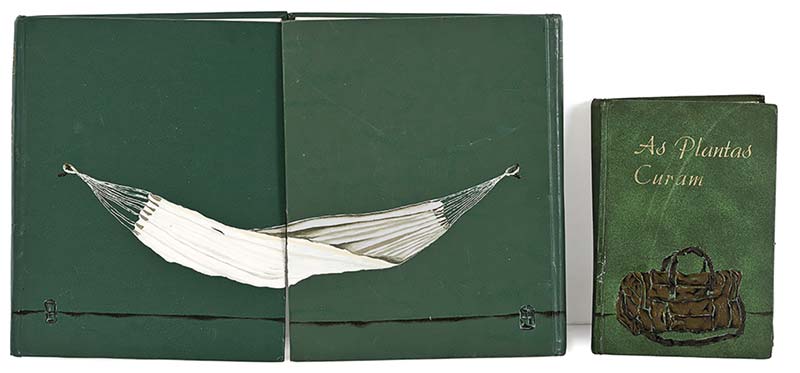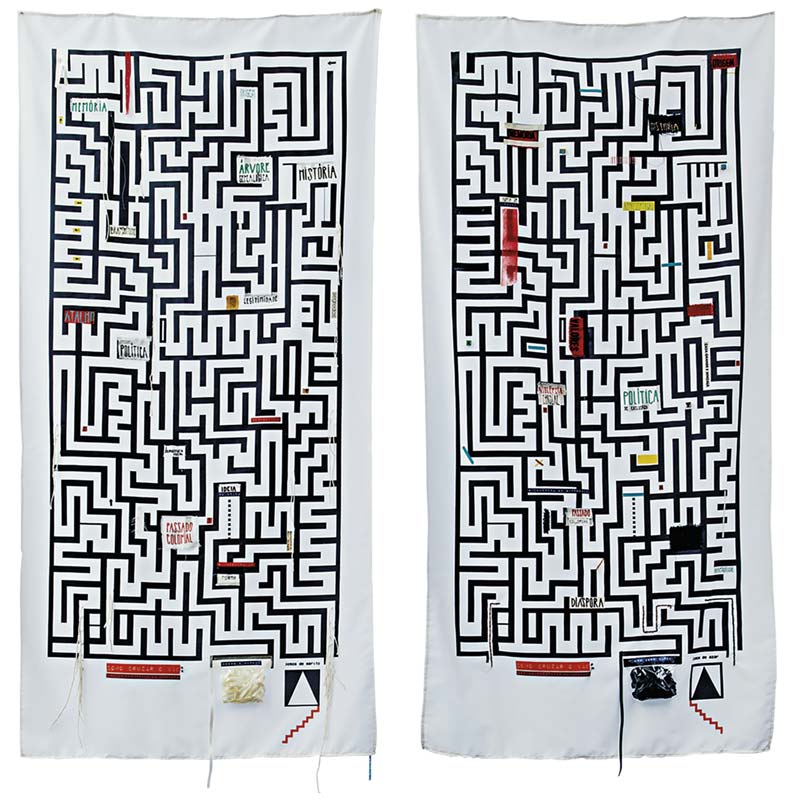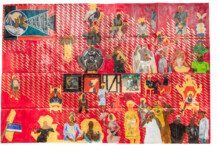What would be a “sertão art”? In the perspective proposed by the curator Júlia Rebouças for the 36th Panorama of Brazilian Art, the concept refers more to a way of thinking and acting than to the geographic and cultural place that we usually associate with the word “sertão”. The public who visit the Museum of Modern Art of São Paulo between August 17 and November 15, therefore, will not find a show about the Brazilian semi-arid or with artists born in it, but rather an exhibition that has “experimentation and resistance” as some of its pillars.
It is, according to Rebouças, “a way of thinking that understands a context and tries to relate to it; which creates solutions from what is available; which does not yield, for example, to the pressures of a hegemonic system, but which will try to find fissures in the classical flows of power”. The curator also refers to an artistic production that “has speculated not only on alternative circuits, but also on other materialities, other authorship relations and collaborations with different disciplines and fields of knowledge”.
It was from this idea of “sertão art” that Rebouças selected the 29 participants from the different regions of the country, most of them born between the 1980s and 1990s. “A generation that has not yet had a great institutional show to their work or have had little room to make their debate happens”, she says, raising current issues about, for example, structural racism and police violence, use of public space, indigenous and environmental causes, gender issues, and the existence of other possible spiritualities.
With a majority of commissioned works, the exhibition brings together works by Ana Lira, Ana Pi, Ana Vaz, Antonio Obá, Fulni-ô Cinema Collective, Cristiano Lenhardt, Dalton Paula, Daniel Albuquerque, Desali, Gabi Bresola & Mariana Berta, Gê Viana , Gervane de Paula, Lise Lobato, Luciana Magno, Mabe Bethônico, Mariana de Matos, Maxim Malhado, Maxwell Alexandre, Michel Zózimo, Paul Setúbal, Yandê Radio, Randolpho Lamonier, Raphael Escobar, Raquel Versieux, Regina Parra, Rosa Luz, Santídio Pereira, Vânia Medeiros and PokaRopa Vulcanica. Read below the full interview with curator Júlia Rebouças.

ARTE!Brasileiros – On the subject of this Panorama, you have already pointed out that with “backwood” it does not necessarily intend to deal with the caatinga, the semi-arid or the states that make up the Northeast, but rather a “sertão art”. What is this “sertão art”?
Júlia Rebouças – The first place is to think of the sertão not as a theme, but as a concept. Because a theme you illustrate, you react to it, and that’s what I’m trying to escape. I think it important to think sertão not only as a cultural place or matrix, but as a way of thinking. And it is in this sense that I speak in a “sertão art”, which I think is a way of thinking that engenders experimentation and resistance; who understands a context and tries to relate to it; which creates solutions from what is available; which does not yield, for example, to the pressures of a hegemonic system, but which will try to find fissures in the classical flows of power. So to speak of an art that has sertão as epistemology is also to ask what practices we are talking about. So I’m here speculating about what those ways of thinking and acting would be, but I’m also trying to find in artists’ practice the places they point to.
And what answers have you found?
It has an aspect that appears in several works in the Panorama that has to do with thinking of art as a mechanism of healing, returning to some issues and wounds that have remained in history, in relationships. They are artists who propose, through their works, either a repair or a process of re-elaboration of historical questions. For example, Dalton Paula, Antonio Obá and Ana Pi. There is another aspect of this sertão epistemology that has appeared that has to do with a certain reverence to the mystery. An understanding that not everything is explained by language, that science does not account for everything, that reason does not reach all things and that there is a set of knowledge, practices and sociabilities that work from what we do not know and does not explain. This manifests itself in spirituality, but simply in that tacit knowledge of knowing that there are things that we exchange and that will never be worked out are in the subtle field.
And when I speak of a “sertão art”, I am also thinking of this half-indomitable feature of the sertão, which is a characteristic I also see in art. However much we try to classify, surround, dominate, control or structure in front of the sertão, this is always a failed task, because the sertão always escapes, it is always something different. It is only to think of all the attempts of the Brazilian culture itself to define what was sertão, from the novel of 1930 to the new cinema. And the sertão can not be defined. There is always a trace of stereotype, or a specific cut, or a look from the outside. And that I think is a feature of art as well. You can conceptualize, delimit, institutionalize and commodify art, but something always escapes. When you realize, the art is beyond. And all the time we are having to update and rework what is art, what are artistic practices, how art deals with power, with politics, with the system. So I think that art has this sertão quality, to be somehow uncolonizable. Although it can be colonized, it has some force of it that does not allow itself to be apprehended.
Does this have to do with their interest in contemplating a production that also exists outside established institutional and marketing circuits?
I think artists have speculated not only on alternative circuits, but also on other materialities, other authorship relations, collaborations with different disciplines and fields of knowledge. And I think that’s by concept what I mean by “sertão art”. Of course they have artists who work in the galleries, with more classical supports, but I do not think that simply by being in the gallery they can not be questioning and seeking other ways of existing and acting. Maxwell Alexandre, for example, is an artist who engages in galleries, exhibits in museums and institutions, but at the same time is always straining, seeking other ways to exist outside of these media – in the community where he lives, for example.
And there are artists who are in university, others who sometimes do not even recognize their practice as artistic practice. So I find this a very interesting place to observe, very pulsating of what we are calling a production of experimentation and resistance. That is not necessarily an opposition to the system and to the market, because I find it interesting to get things done all the time. And it is part of this practice to seek other forms of existence that are not submitted. This is what I think that matters, you are not subject to the dictates of the market, the institutions or the wishes of the healers.
Professor Durval Muniz says that the sertão is a multiple experience, although it tends to be narrated from certain clichés. Does your proposal have considers fighting cliches and stereotypes around the idea of the sertão?
Yes, because it is not “over” the sertão. When we talk about the sertão as a theme, it has this place of reiteration of an image and an identity that are part of a political project, done largely for the submission of the sertão itself or the Northeast itself – since the sertão and the Northeast are often treated almost synonymous. So it is crucial to escape from this, not to reiterate these clichés. To some extent I think it would be important to talk about some fundamentals of a Northeastern production or very important artists that are in the semi-arid, but I resisted it. Because I thought that would be the easiest way, to try to pass on this direct production, this direct image. And when we look, for example, we have the exposure to the Northeast, which I even joked about as if it were the theoretical foundation of Panorama. We have the book by Durval, the play A Invenção do Nordeste, which won the Shell Award, the book À Cidade by Mailson Furtado, we have Flip also talking about this theme. So I think these clichés and the need to deconstruct them, this is put, is in the debate. And I wanted with Panorama to take a step in another direction, to think of the sertão not as this set of images and affections, but as this way of thinking and existing.

Mariana de Matos, Vão, 2017
And speaking more directly of the artists, how was the choice of these 29 names?
I tried to identify artists who already had a “sertão practice”, rather than picking people up and making them react to a featured theme. Of course, every selection is partial, limited. There are a number of other artists I could be working with. But, anyway, I wanted to have some regional diversity because I find it important to do the exercise of looking at less obvious places, and there was an exercise to try to break this structure a bit in which the exposures are mostly made by white men. Then there are more non-whites than whites and more women than men. This was not exactly a goal, but I think everyone who works today has to worry about another type of representation. And I think that in those places, which are less visible or less represented, is where normally, by nature, there is more experimentation and resistance. More of this “sertão art”.
When you speak of resistance, it is impossible not to think about the political context we are living in, with a conservative government and very forceful speeches against art and culture. Is Panorama’s curatorial line also a kind of response to this?
I think Brazil is in a very critical moment in terms of politics, in its social relations, in the way of building its places of affection and the possibilities of meeting. Not to mention the more structural issues with regard to culture. But I do not think Panorama is an answer, because it’s all very old and at the same time very new. Especially during the election period, it was very clear that it is necessary to reorganize, that any strategy of opposition to this government needs to be reworked, because many tactics and practices have been overcome, overcome. And I think this is about art as well, to think how art will react. I think any immediate reaction will be superficial and superficial. What is sometimes necessary in the heat of the moment, but I think perhaps this Panorama will try to discuss more what would be a tactical thought or strategies of reorganization of that resistance than to bring answers or offer a frontal and direct confrontation. Many artists are making a diagnosis of what is happening in the present, but many are speculating on ways to exist. They are talking about how dissident bodies will be able to exist from now on, how they have existed up to that moment, how to make a historical reparation, how to degrade practices of violence and oppression. I think that, in this sense, it is also a desire that it be a propositional exposition, not with solutions or answers, but with notes, trying to organize a little these affections of a rally and the need to exist before the dismantling.
Do you fear any kind of negative or violent reaction, considering what we have seen happen in Brazil in recent years?
We do not work in fear or with any kind of restriction. Of course, any reactionary structure is afraid of art. They are the ones who are afraid of creation, of imagination, of critical thinking. This becomes very clear when the focus of attack is not only art, but education, science, universities. Only an extremely reactionary project needs so strongly to disqualify and dismantle the possibilities of creation. In fact, it is very logical that this government is afraid of everything that generates the new, that sets us in motion. And we already understand that in front of factoids and lies there are terrible lynchings. So I am dealing with very powerful content, very rich, but I do not think they are more dangerous to be attacked, more likely to be censored, because anything is liable to be attacked and censored, especially the lies created. Many of these issues created around art are false issues, they are invented polemics. So we can not work thinking about it, we have to work thinking about what needs to be done.








